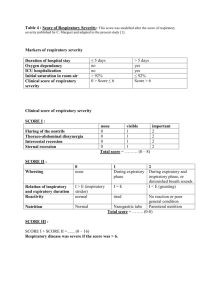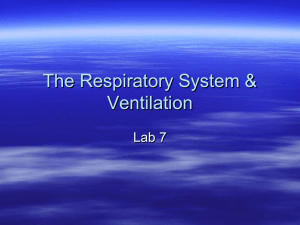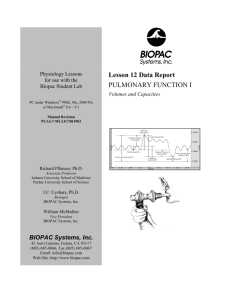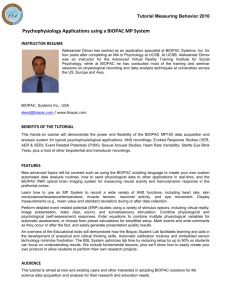SPIROMETRY * RESPIRATORY VOLUMES AND CAPACITIES
advertisement
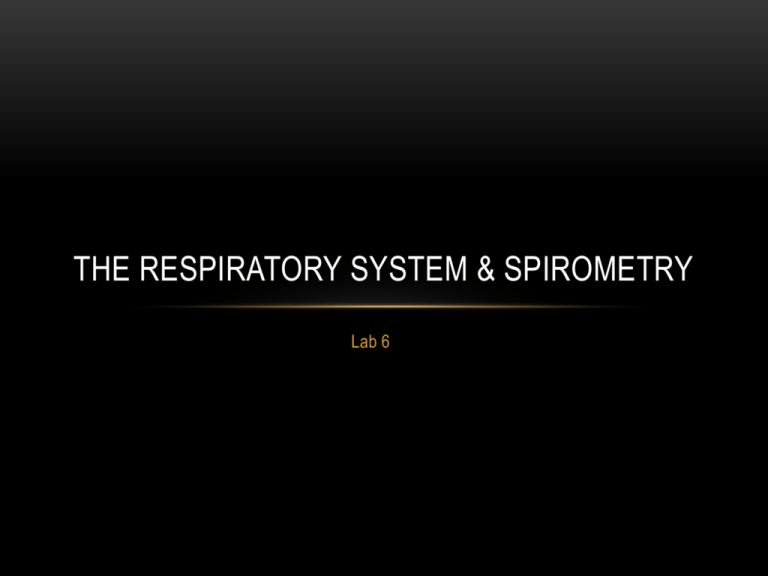
THE RESPIRATORY SYSTEM & SPIROMETRY Lab 6 LAB 6 ACTIVITIES • Identify parts of the respiratory system • Respiratory tree, thoracic organs, and larynx models • Fresh lung (if available) • Examine histology of the: • Trachea • Lung • Examine the operation of the lung model • Biopac L012-Pulmonary Function I • Measure lung volumes and capacities RESPIRATORY SYSTEM STRUCTURE 1. Conduction zone: pathway for pulmonary ventilation 2. Respiratory zone: membrane for gas exchange external respiration • Clinically, two parts: • Upper respiratory tract • Lower respiratory tract RESPIRATORY SYSTEM STRUCTURE Histology reflects the different functions of the different parts of the system Position in respiratory pathway determines cell type • non-keratinized stratified squamous • pseudostratified ciliated columnar • cuboidal ciliated • simple squamous / Type I Alveolar cells PSEUDOSTRATIFIED COLUMNAR EPITHELIUM mucosa Lamina Propria Submucosa Hyaline Cartilage seudostratified epithelium = lamina propria ucous glands mooth muscle artilage GROSS SECTION THROUGH LUNG Smoker’s Lungs Non-smoker SMALL BRONCHIOLE LUNG TISSUE SLIDE Respiratory Bronchiole Alveolar Duct Alveoli Alveolar Sac CAPILLARIES IN ALVEOLAR WALL SPIROMETRY SPIROMETRY – RESPIRATORY VOLUMES AND CAPACITIES Total Lung Capacity = Inspiratory Reserve Volume (IRV) + Tidal Volume (TV) + Expiratory Reserve Volume (ERV) + Residual Volume (RV) Vital Capacity = Inspiratory Reserve Volume (IRV) + Tidal Volume (TV) + Expiratory Reserve Volume (ERV) Inspiratory Capacity = Inspiratory Reserve Volume (IRV) + Tidal Volume (TV) Functional Residual Capacity = Expiratory Reserve Volume (ERV) + Residual Volume (RV) SPIROMETRY: CALIBRATION Inlet Insert the calibration syringe/filter assembly into the side of the airflow transducer labeled "Inlet." Inlet Follow pop up window instructions Wait for 8 seconds of no air flow, Then do your 5 syringe cycles. Experimental Treatments- Different from Biopac!!!! and don’t forget the nose clip!!! 1. 2. 3. 4. 5. 6. 7. 8. 9. 10. 4 normal breaths (4 inhales/4 exhales) Inhale as deeply as possible Exhale to normal depth 3 normal breaths Exhale as much as possible at end of 3rd exhalation 3 normal breaths Inhale as much as possible, then exhale as fast and completely as possible (you will use this data segment in activity 3) 3 normal breaths Click Stop- look at your recording and redo if necessary If it’s good, select done and analyze your data. BIOPAC SPIROGRAM EXAMPLE DATA If you get a negative value, just put the absolute value. This part is in addition to what Biopac Lesson 12-Lung 1 prompts you to do! 1 regular exhale 1 strongest inhale 3 regular breaths 1 strongest inhale 3 regular breaths 1 strongest exhale 3 regular breaths 1 strongest exhale BIOPAC: DATA ANALYSIS Ch 2 P-P Measures Tidal Volume Record in Table 1 on page Lab 6-17 BIOPAC: DATA ANALYSIS P-P Measures Inspiratory Capacity Record in Table 1 on page Lab 6-17 BIOPAC: DATA ANALYSIS Delta Measures Inspiratory Reserve Volume Record in Table 1 on page Lab 6-17 Use similar methods to determine: Expiratory Reserve Volume Vital Capacity BIOPAC: DATA ANALYSIS (ACTIVITY 5) Forced Expiratory Volume is the % of your forced vital capacity you can expel in 1,2, or 3 seconds. RESET MEASUREMENT BOXES!!!!! BOX 1- DELTA T BOX 2 P-P, ALL OTHER BOXES- NONE USE I-beam to bracket one second of data starting at peak of last maximal inhalation. P-P will give you FEV1 then highlight the 1st 2 seconds of data starting at peak for FEV2 and then the 1st 3 seconds for FEV3 Record in Table 1 on page Lab 6-17 BIOPAC: DATA ANALYSIS To measure FVC highlight the recording from just before last maximal inhalation to just after peak of the last maximal exhalation- use P-P value. Record in Table 1 on page Lab 6-19 SUMMARY OF CLASS DATA Record your data in Excel at the computer located at the front podium Your Instructor will make the complete data set available for you to use while completing the homework assignment HOMEWORK Complete and turn in the questions on pages 6-17 to 6-20 Don’t forget to print the entire spirogram (landscape format) you recorded to include in your lab report. Use vertical brackets ( [ ] ) to identify and label the tidal, inspiratory reserve, expiratory reserve and residual volumes; and total lung, vital, expiratory and inspiratory capacities on your spirogram . Lab 6-19, Question 4. Remember to completely label your graphs! Complete Assignment 6 on MasteringAandP. THE END Lab 6 Biopac Spirometry Residual volume SPIROMETRY
